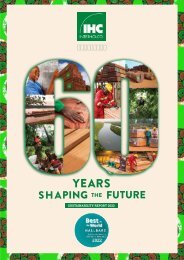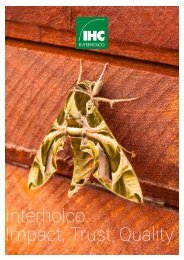Nomenclature Générale des Bois Tropicaux - 7ème édition
(english description below) Cette nomenclature est utilisée pour la mise à jour du 'Harmonized Code System' de l’Organisation Mondiale des Douanes. Dans la circulaire du 5 avril 2005, le Ministère de l’Economie, des Finances et de l’Industrie (France) reconnaît l’ATIBT comme « gardien du temple » de la nomenclature des bois tropicaux. La Commission Européenne mentionne la nomenclature de l’ATIBT comme document de référence pour la mise en œuvre du RBUE. Depuis 1954, l’ATIBT a établi et mis à jour une nomenclature des bois tropicaux faisant correspondre chaque espèce botanique avec un nom pilote reconnu internationalement. La détermination du nom pilote d’une essence est cruciale, car sa commercialisation dépend très largement de l’adoption de ce nom par le public. Le nom pilote assure la protection de l’appellation commerciale de l’essence et l’intégrité des propriétés qui lui sont attribuées, sans risque de confusion. The 1982 version of the general timber nomenclature has finally been updated as some of the 1,750 identified species, are no longer traded, while others, which were not previously included, are now on the market. The present revision has also integrated changes related to new taxonomy, in order to reflect the latest scientific developments. This Nomenclature has been used for the Harmonized Code System, updated by the World Customs Organization. The French Ministry of economy, finance and industry has given official recognition to ATIBT as the reference for the tropical timber nomenclature (NOR: PRMX0508285C of April 5th 2005). The European Commission refers to ATIBT nomenclature as a reference document for the implementation of the EUTR regulation. Since 1954, ATIBT has established and updated a nomenclature of tropical wood, linking each botanical species with an internationally recognized pilot name. A sigle wood species may have many common names; when trading across different countries, this may lead to confusion. Fixing the pilot name of a timber species is crucial, to protect the commercial denomination of the species and guarantee the veracity of the properties linked to that species, without confusion.
(english description below)
Cette nomenclature est utilisée pour la mise à jour du 'Harmonized Code System' de l’Organisation Mondiale des Douanes. Dans la circulaire du 5 avril 2005, le Ministère de l’Economie, des Finances et de l’Industrie (France) reconnaît l’ATIBT comme « gardien du temple » de la nomenclature des bois tropicaux. La Commission Européenne mentionne la nomenclature de l’ATIBT comme document de référence pour la mise en œuvre du RBUE.
Depuis 1954, l’ATIBT a établi et mis à jour une nomenclature des bois tropicaux faisant correspondre chaque espèce botanique avec un nom pilote reconnu internationalement. La détermination du nom pilote d’une essence est cruciale, car sa commercialisation dépend très largement de l’adoption de ce nom par le public. Le nom pilote assure la protection de l’appellation commerciale de l’essence et l’intégrité des propriétés qui lui sont attribuées, sans risque de confusion.
The 1982 version of the general timber nomenclature has finally been updated as some of the 1,750 identified species, are no longer traded, while others, which were not previously included, are now on the market. The present revision has also integrated changes related to new taxonomy, in order to reflect the latest scientific developments.
This Nomenclature has been used for the Harmonized Code System, updated by the World Customs Organization. The French Ministry of economy, finance and industry has given official recognition to ATIBT as the reference for the tropical timber nomenclature (NOR: PRMX0508285C of April 5th 2005). The European Commission refers to ATIBT nomenclature as a reference document for the implementation of the EUTR regulation.
Since 1954, ATIBT has established and updated a nomenclature of tropical wood, linking each botanical species with an internationally recognized pilot name. A sigle wood species may have many common names; when trading across different countries, this may lead to confusion. Fixing the pilot name of a timber species is crucial, to protect the commercial denomination of the species and guarantee the veracity of the properties linked to that species, without confusion.
Create successful ePaper yourself
Turn your PDF publications into a flip-book with our unique Google optimized e-Paper software.
Liste des noms vernaculaires avec renvoi au nom pilote /// 115
NOMS VERNA-
CULAIRES
COMMON
NAMES
PAYS
COUNTRY
Kememjing ID Kandis
Kempakai ID Champak
Kempas MY Kempas
Kempas PG Kempas
NOM PILOTE
PILOT NAME
Kenari ID Kedondong
Keranji ID Keranji
Keranji MY Keranji
Keranji MY Lilin
Kerbau MY Rengas
Kereti-Silverballi GY Louro branco
Keruing ID Keruing
Keruing Bajak MY Keruing
Keruing Beras MY Keruing
Keruing Gaga MY Keruing
Keruntum MY Keruntum
Kesindu MY Kulim
Kesse CG Difou
Ketjapi ID Sentul
Kevazingo GA Bubinga
Kha hot TH Kayu Hujan
Kha Nang LA Malas
Khabhari IN Yemane
Khai Khieo TH Gerutu
Kha-Nunnok TH Nyatoh
Khanun-pa TH Keledang
Khasya-Pine IN Pinus Kesiya
Khayah MM Manilkara
Khen Nang MM Malas
Khian TH Xoan
Khilek TH Djohar
Khleng TH Keranji
Khlong KH Keruing
Ki bulu MY Kasap
Ki Hujan ID Kayu Hujan
Kia VN Pinus Merkusii
Kiaat ZA Muninga
Kiansonso CD Kiasose
Kiantioutiou GF Araracanga
Kiasose CD Kiasose
Kiasose CG Kiasose
Kibakoko CD Kibakoko
Kibakoko CG Kibakoko
NOMS VERNA-
CULAIRES
COMMON
NAMES
PAYS
COUNTRY
NOM PILOTE
PILOT NAME
Kiharpan ID Kedondong
Kijeri ID Kandis
Kikenzi CD Kikenzi
Kikubi-Lomba CG Ekoune
Kikwaju KE Grenadillo
Kiliakamba CG Diania
Kilifi KE Mtandarusi
Kilingi UG Bilinga
Kilu CF Bilinga
Kilula CG Tiama
Kimiseh CD Okoué
Kirundu UG Ako
Kisasamba CG Pao rosa
Kisésé CG Padouk d’Afrique
Kissinhungo AO Kotibé
Kitoke ID Siris
Kitola CG Tchitola
Klinki AU Klinki
Koanan PG Batino
Kobé GF Chicha
Kobehe SR Chicha
Kocolorelli SR Pau roxo
Kodathani IN Mabin
Koebesini SR Burada
Koemaka SR Sumauna
Koemaroe SR Cumaru
Koenatepi SR Macacaúba
Koepajoewa SR Copaiba
Koepi SR Cupiuba
Kofina CI Eyoum
Koframiré CI Osanga
Kofyo CF Azobé
Koila SB Bintangor
Kojagei SL Limba
Koki KH Merawan
Koki Phnom KH Meranti, White
Kokoti GH Bodioa
Kokriki SR Tento
Kokrudua GH Afrormosia
Kolo NG Mukarati
Kolomeko CF Ekoune
Kolon LK Haldu














